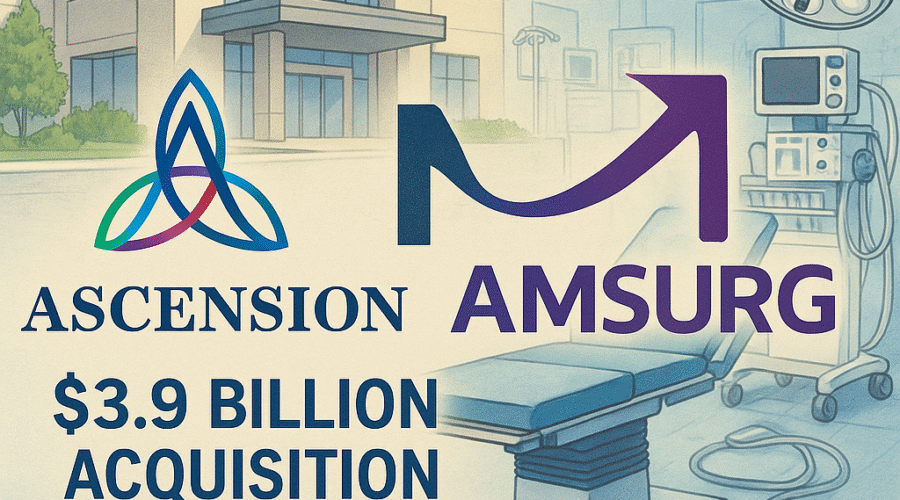As healthcare systems grapple with post-pandemic financial pressures and evolving care delivery models, Ascension Health’s potential $3.9 billion acquisition of AmSurg represents a watershed moment in hospital strategy. This transaction – one of 2025’s largest healthcare deals – signals a fundamental reorientation toward outpatient infrastructure amid systemic shifts in reimbursement models, patient preferences, and private equity’s growing influence in care delivery[9][10][17].
💼 Seasoned CorpDev / M&A / PE expertise
Strategic Rationale: Building an Outpatient Fortress
Addressing Systemic Margin Pressures
Ascension’s reported $1.8 billion operating loss in FY2024 underscores the urgency behind this transaction[9]. With inpatient margins collapsing under CMS payment reforms and labor inflation, the system’s 18.1% year-over-year growth in outpatient surgery volumes reveals where sustainable profitability lies[17]. AmSurg’s network of 250+ ASCs across 34 states immediately positions Ascension as the nation’s second-largest ASC operator, creating critical mass in high-margin procedural verticals like gastroenterology and ophthalmology[1][16].
Vertical Integration Synergies
The deal enables closed-loop care coordination between Ascension’s 142 hospitals and AmSurg’s outpatient facilities. This mirrors UnitedHealth’s Optum-Surgical Care Affiliates integration playbook, where health systems capture the full continuum of surgical episode economics[11]. Early analysis suggests 15-25% cost savings per outpatient procedure versus inpatient settings could translate to $450M+ annual EBITDA uplift at scale[16][17].
Financial Architecture: Balancing Risk in a High-Leverage Environment
Capital Structure Considerations
With AmSurg’s complex capital stack including PIMCO, King Street Capital, and Partners Group positions[1], Ascension must navigate $2.1B+ of existing leverage while maintaining investment-grade ratings. The transaction’s rumored 8.5x EBITDA multiple (based on AmSurg’s $460M 2024 EBITDA) suggests aggressive growth assumptions given current interest rate environments[9][10].
Portfolio Realignment Dynamics
This acquisition continues Ascension’s asset rotation strategy, having divested 19 hospitals since 2023 to fund ambulatory investments[9]. The system’s March 2025 SEC filings reveal $2.3B earmarked for ASC development – capital now likely redirected toward this transformational deal[17].
Regulatory Landscape: Navigating New Antitrust Realities
Market Concentration Risks
In 34 states where both entities operate ASCs, the combined market share exceeds 30% – triggering likely FTC scrutiny under revised 2024 merger guidelines. Ascension may need to divest 40-50 centers to secure approval, particularly in Texas and Florida where AmSurg has concentrated assets[1][10].
Catholic Health Directive Implications
Ascension’s Ethical and Religious Directives could necessitate service changes at AmSurg’s 58 women’s health centers. This creates potential valuation write-downs of $120-150M if reproductive service lines require restructuring[9][18].
Operational Integration: The Physician Alignment Challenge
Consensus Management Model Pressures
AmSurg’s physician partnership structure – where doctors hold 51% ASC ownership – conflicts with Ascension’s traditional employed-physician model[16]. Successful integration requires renegotiating 2,000+ physician contracts under value-based care frameworks, a process that took HCA Healthcare 3+ years post-Envision acquisition[11].
Technology Stack Integration
Merging Ascension’s Epic EHR system with AmSurg’s proprietary SurgiSource platform presents $85-100M in IT integration costs. However, unified data analytics could yield $12-15M annual savings through improved supply chain optimization and case mix analysis[16][18].
Market Implications: Reshaping the ASC Landscape
Private Equity Countermoves
KKR and Bain Capital are reportedly evaluating competing bids for Surgery Partners and USPI assets, anticipating consolidation wave[11][13]. The AmSurg deal could trigger 20-30% valuation premiums across top-quartile ASC platforms through 2026.
Payer Strategy Shifts
UnitedHealthcare and Cigna are revising narrow-network contracts to account for Ascension’s expanded outpatient footprint. Early estimates suggest 15-20% improved rate negotiation leverage in 12 key markets[9][16].
Conclusion: The New Care Delivery Calculus
This acquisition exemplifies health systems’ existential pivot toward capital-light, consumer-centric care models. While integration risks remain substantial, Ascension’s bold repositioning could establish a blueprint for surviving healthcare’s value-based transition. The deal’s ultimate success will hinge on executing complex physician alignments and demonstrating measurable cost per episode reductions – the new currency in American healthcare.
Sources





